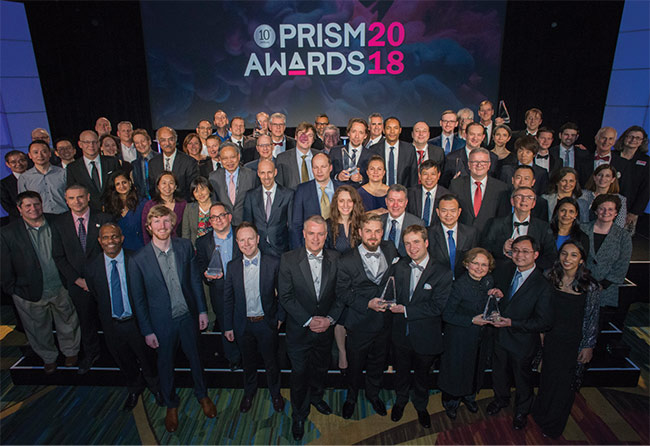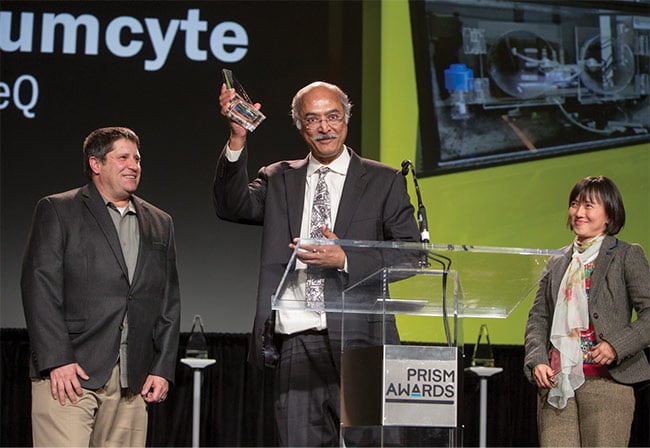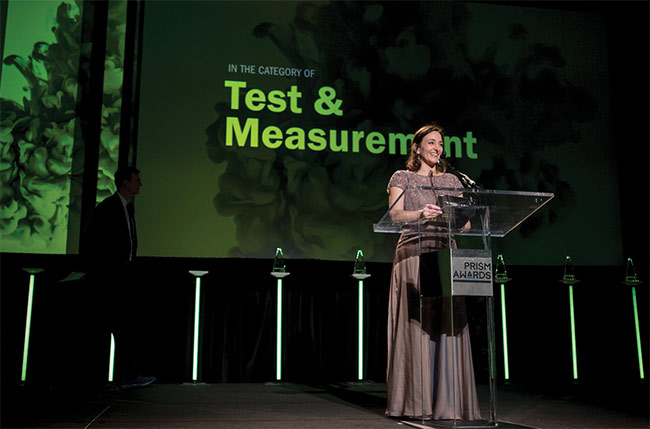POLINA POTOCHEVSKA, EDITORIAL ASSISTANT
Retinal projection laser eyewear, the world’s first cloud-based AI hand-held Raman spectrometer, and the first accurate stereo photogrammetry device that fits in the palm of a hand will all converge at the 2019 Prism Awards for Photonics Innovation.
These innovative products are just three of the 30 finalists for the awards, which recognize groundbreaking technology in the industry. On Wednesday,
Feb. 6, co-sponsors SPIE and Photonics Media will hold the 11th annual awards gala in San Francisco, where the winners will be announced. According to SPIE’s award website, “This was an exceptional year of exceptional products.”

2018 Prism Award winners. Courtesy of SPIE.
The Prism Awards recognize outstanding examples of a range of imaginative and innovative photonics R&D. Prism Awards 2018 judge Laura A. Smoliar, managing director at Berkeley Catalyst Fund, wrote, “The Prism Awards give well-deserved recognition to technical teams in the industry who have climbed over one of the most challenging walls, bringing a leading-edge product from an R&D lab to the market.”
Detectors and Sensors
CloudMinds Technology Inc.
(California, U.S.)
The XI AI Raman Spectrometer is the world’s first cloud-based AI hand-held Raman spectrometer with 785-nm laser excitation. Featuring an intuitive user interface, the XI AI Raman Spectrometer is integrated with the CloudMinds’s Data A1 smartphone and is the only Raman spectrometer that can also be used as a smartphone for emails, geolocation, and maintaining connection to the cloud. The cloud data platform enables instant data uploads and updates for all field devices and maintains connection to the cloud via a cellular link even when Wi-Fi is not available. It can be employed in the consumer market for the detection of counterfeits, including drugs and jewelry, and for monitoring contaminants in food.
Hamamatsu Corp. (New Jersey, U.S.)
The world’s smallest grating-type spectrometer, the C14384MA minispectrometer (SMD series), is a grating-based shortwave-NIR spectral sensor head designed and fabricated through MOEMS technology. Slightly wider than 1 cm and with an input slit of 20 µm, incoming light is dispersed by a nanoimprinted reflective grating and imaged onto a custom CMOS active-pixel image sensor. The extremely compact and lightweight design has a spectral response range of 640 to 1050 nm and will facilitate hand-held and portable field analysis applications.
ImpactVision (California, U.S.)
ImpactVision’s Real-Time Food Quality Decisions software applies hyperspectral imaging technology to food supply chains in order to deliver consistent food quality and reduce supply chain waste. The software is IP65 graded and fully customizable. It helps maximize yields and prevent product recalls through real-time identification of foreign objects up to 0.5 mm in size. A third of all food produced in today’s world is wasted; ImpactVision digitizes food quality control to save time, prevent food waste, and increase food companies’ revenues.
Diagnostics and Therapeutics
Convergent Dental (Massachusetts, U.S.)
Solea is the only CO2 9.3-μm dental laser cleared by the FDA for all-tissue applications such as cavity preps, soft tissue procedures, and osseous (bone)procedures. Solea is a versatile laser that can be used on hard, soft, and osseous tissues both anesthesia free and suture free. Patients experience a painless procedure and a speedy recovery period, and doctors may increase volume by four to six procedures per day using this technology.

Bidhan Chaudhuri, founder and chief technology officer of Quantumcyte, accepts the 2018 Prism Award in the Life Science and Instrumentation category along with John Butler, CEO (left), and Bernadine Lim, vice president of international business development. Images courtesy of SPIE.
Double Helix Optics (Colorado, U.S.)
Used for biological and biomedical research and drug discovery, the extended-depth imaging and axial precision of the SPINDLE nanoimaging system allows for the study of cellular structures down to the single molecule level in 3D. SPINDLE can capture high-precision, superresolution 3D images, enabling collection of significantly more data in a single shot of up to 20 µm. It can be easily installed on existing microscopes, making 3D superresolution imaging and tracking accessible and affordable.
RedShift BioAnalytics Inc. (Massachusetts, U.S.)
Specifically designed for the characterization of protein therapeutic drugs, the AQS3pro protein analyzer analyzes the drugs’ biophysical structure using the newly invented technology of microfluidic modulation spectroscopy (MMS). The AQS3’s most unique feature is measurable concentration range. It can characterize proteins at concentration ranges from 0.1 to over 200 mg/mL, and also features measurement sensitivity and accuracy to an automated suite of analytical tools for protein analysis.
Imaging and Cameras
Ajile Light Industries (Ontario, Canada)
The DepthScan is a high-speed, high-accuracy 3D imaging system based on projected structured light patterns, consisting of Ajile’s digital micromirror device (DMD)-based projector and smart camera synchronized with integrated image processing. Designed for vision-guided robotics, industrial inspection, and metrology in manufacturing environments, the working distance ranges from 25 to 150 cm.

Danielle Wuchenich, vice president at Liquid Instruments, presents the 2018 Prism Award in the Test and Measurement category. Images courtesy of SPIE.
Leica Geosystems (Heerbrugg, Switzerland)
The first accurate stereo photogrammetry device that fits in the palm of your hand, the BLK3D looks like a smartphone but is a 3D measurement and documentation machine engineered to deliver accurate 3D measurements derived from 2D images. With no internet connection or cloud app required, its software features powerful edge detection and a user-friendly experience. The BLK3D makes design software and digital project management accessible to a wide range of construction and real estate management professionals by capturing stereo imagery and enabling 3D measurement
of visible elements in real time.
RDI Technologies Inc. (Tennessee, U.S.)
The Iris MX is a motion amplification camera that leverages its high speed for frame rates over 10,000 fps, making it able to detect and amplify subtle motion to a level visible to the naked eye in video. The Iris MX measures displacements
by drawing a region of interest in the video and displaying a time waveform and frequency spectrum for that location.
The spectrum can measure motions up to 5000 Hz with absolute measurement.
Industrial Lasers
Civan Advanced Technologies Ltd. (Jerusalem, Israel)
An innovation in the additive manufacturing field of 3D printing, the High Power Laser using Coherent Beam Combining (CBC) technology for materials processing is a 10-Kw single-mode laser with electro-optical-controlled dynamic beam. Civan’s CBC technology allows flexible, digital, and electronic control of beam steering, beam shaping, intensity modulation, and dynamic focusing. The outcome is ultrafast beam oscillation that improves process efficiencies in terms of both processing time and quality.
nLIGHT Inc. (Washington, U.S.)
The nLIGHT Corona is a revolutionary fiber laser with rapidly tunable beam quality for a variety of applications such as cutting, welding, and additive manufacturing. For sheet metal cutting, Corona provides up to 5 kW, with a beam diameter (tunable between 100 and 350 μm) and a variety of beam shapes. Its key innovation is the ability to tune beam characteristics completely within optical fiber, which is applicable to a variety of laser sources at all power levels, pulse formats, and operating wavelengths.
TRUMPF Laser- und Systemtechnik GmbH (Ditzingen, Germany)
As an industrial solution for the complete process chain for metal 3D printing, the TruPrint 5000 is a highly productive, semiautomatic laser metal fusion (LMF) machine. It features 500 °C preheating and a fullfield multilaser with three 500-W lasers that simultaneously scan the entire building area to maximize productivity. The TruPrint 5000 is effective in multiple industries, including energy, aerospace, medicine, and automotive.
Light Sources
Gamma Scientific (California, U.S.)
The RS-7-SWIR is a tunable SWIR source that allows image sensor manufacturers and integrators to characterize quantum efficiency, spatial nonuniformity, crosstalk, and dynamic range. Featuring a gold-coated integrated sphere with 75-mm output port, built-in optical feedback, and light output from 900 to 1700 nm, the RS-7-SWIR can be deployed in automotive, security, and defense applications, as the expanded wavelength improves performance in low visibility and nighttime environments.

Darius Sankey, venture capitalist and co-president at Ocean Tomo, presents the 2018 Prism Award in Environmental Monitoring. Images courtesy of SPIE.
SLD Laser (California, U.S.)
Featuring 400 lm, 2° beam angle, and 1-km range, the LaserLight MicroSpot module is the world’s first spotlight module that couples LaserLight SMD with a compact 35-mm diameter collimating optic. It enables ultralong throw distance for long-range applications (up to 10× that of LED) and is compatible with high-efficiency wavelength delivery. The LaserLight MicroSpot module makes it possible to use a small, portable illumination system with white light to offer distant visibility.
Smart Vision Lights (Michigan, U.S.)
NanoDrive is an LED light driver that enables lights to be full on in nanoseconds. The driver can supply full current to the LED in 50 ns and can provide up to hundreds of amps. Vision inspection applications that require fast image acquisition or short image exposure — such as robotics, illumination (LED luminaires), and other machine vision applications — can benefit from the NanoDrive.
Optics and Optomechanics
Dover Motion (Massachusetts, U.S.)
The DOF-5 is a nanopositioning stage optimized for optical imaging applications. Featuring brushless linear motor technology, stiff cross-roller guide rails, a built-in motion controller, and an embedded internal motion controller and drive circuit, the DOF-5 is user-friendly and more affordable than its competitors. It provides better performance at lower cost for OEMs in the life sciences, in vitro diagnostics, semiconductor, and metrology industries.
Modular Photonics (New South Wales, Australia)
Modular Photonics’ OMPlex passive silica chips increase data transmission rates and reach in legacy public and enterprise optical fiber networks. The OMPlex solution supports speeds of 1 Gb/s, 10 Gb/s, and 40 Gb/s over 2 kms of all types of multimode fibers. OMPlex offers 100× the increase in data transfer speed at one-tenth of the cost and one-tenth of the time needed to recable, as it allows for future-proofing fiber networks without recabling.

2018 Prism Award winners from Spheryx Inc. From left: Jaroslaw Blusewitz; Priya Kasimbeg; Laura A. Philips, president and CEO; and Fook Chiong Cheong. Images courtesy of SPIE.
Nikon Corp. (Tokyo, Japan)
SiO2 glass has excellent properties but limited applications because of its high cost. Nikon’s 4D Free-Form Silica Glass can be given shape freely, like resin materials, while also having the properties of silica glass, thus extending the life of optical instruments and increasing their performance. The 4D Free-Form Silica Glass also features high transmittance in wide wavelength regions and high heat resistance compared to typical optical materials.
Scientific Lasers
Chromacity (Edinburgh, Scotland)
The Chromacity OPO-CX is a compact, highly stable, ultrafast optical parametric oscillator (OPO) that delivers ultrashort pulses across the NIR (from 1.48 to 4.2 μm) for imaging and spectroscopy markets. Featuring a fully integrated pump source, with an average power of up to 800 mW from the signal port and 350 mW from the idler port, the OPO-CX is a compact one-box solution that is simple to use and cost-effective.
Spark Lasers (Gironde, France)
ALCOR 920 nm, 2W is an ultracompact, sub-140 fs, fiber-based laser source — operating at a fixed frequency of
80 MHz at 920 nm — that delivers 2 W and targets two-photon imaging applications at less than 140 fs for neuroscience. To be used for biophotonics, medical diagnostics, medical imaging, and life sciences research, ALCOR is the cost-effective solution as a low-maintenance fiber laser technology with high-performance femtosecond laser pulses in an ultracompact, air-cooled, and robust laser head.
TOPTICA Photonics Inc. (New York, U.S.)
The DLC TOPO is the only continuous-wave laser that allows automated, hands-free, high-power, tunable access to MIR wavelengths in the 1.45- to 4.0-µm range. Also featuring a programmable interface for integration into applications such as biophotonics, defense and security, and aerospace, the DLC TOPO is a more stable and user-friendly automated solu-
tion packaged in a convenient system.
Test and Measurement
4D Technology Corp. (Arizona, U.S.)
A hand-held, shop-floor defect inspection and quality assurance gauge for manufactured parts, the 4D InSpec XL makes instant 3D measurements of surface features. It features 2.5-μm resolution and a large 15- × 15-mm field of view and employs fringe projection and dynamic interferometry, making the device suitable for 3D quantification of macro structures such as rivets and counterbores, which were previously impossible to image in a snapshot measurement.
InterOptics LLC (Arizona, U.S.)
OptoFlat is a large-aperture, low-coherence interferometer for measuring the flatness of plane surfaces and wavefronts with Angstrom precision over a 100-mm aperture. Its unique, engineered coherence with LED illumination enables high precision (without coherent noise artifacts), simple parts handling, and vibration robustness — all provided in
a cost-effective package.
SmarAct GmbH (Lower Saxony, Germany)
Designed for high-resolution imaging of vibrational modes of micromechanical systems, the PICOSCALE Vibrometer uses a single laser beam for simultaneous microscopic imaging and interferometric measurements. Out-of-plane vibrations <1 pm and in-plane motion <10 nm can be measured. The microscope uses confocal optics to distinguish between multiple layers, becoming a powerful
tool for investigating and characterizing high-density MEMS structures in combination with the IR light of PICO-SCALE.
Transportation
Alta Devices Inc. (California, U.S.)
The AnyLight Gen4 Solar Cell is a high-efficiency, lightweight, flexible solar cell that employs Alta’s world-record, single-junction solar cell technology at 28.9 percent. The cell has a high power-to-weight ratio of 2000 W/kg, and a low weight-to-area ratio of 110 g/m2. Used in applications such as IoT, electric cars, and electric aircraft, it is suited to powering or extending the endurance of devices that depend on batteries.
Blackmore Sensors and Analytics Inc. (California, U.S.)
Blackmore’s automotive Doppler lidar system is the first such system for autonomous driving in the world. It delivers instantaneous velocity, the mission-critical element of performance for autonomous vehicles. Using frequency modulated continuous-wave lidar to gather velocity measurements of every detected point, vehicles can safely navigate with submillisecond latency. Its lidar is immune to interference from sunlight or other sensors and is economically efficient.
OFS (Connecticut, U.S.)
Designed to ensure reliable data communications on commercial aircraft, the FlightLinx PLUS Fiber Optic Cable is an optical cable used for inflight entertainment, internet access, networking, and display systems. It is a 1.8-mm ruggedized single-jacket cable design consisting of a tight buffered fiber within a loose structure cable, allowing for reliable pull-proof termination, which also helps prevent kinking, epoxy wicking, and fiber breakage during and after deployment.
Vision Technology
AlphaMicron Inc. (Ohio, U.S.)
CTRL Eyewear is the only commercial eyewear with an electronic tint-on-demand capability that can automatically or manually adapt to different lighting conditions in less than a second. The fast switching of clear and tinted lenses makes the product great for athletes, motorcyclists, and the U.S. military — providing UV protection and protection against glare, as it can achieve instantaneous tinting without degradation in optical quality and mechanical impact.
Optotune Switzerland AG (Dietikon, Switzerland)
Optotune’s Extended Pixel Resolution Beam Shifter XPR-25 is an extended-pixel resolution 4-position actuator. By tilting a 2-mm-thick window, the light passing through it gets shifted
by 2.7 µm, half the width of a 5.4-µm pixel. It was designed for Texas Instruments’ 0.47-in. digital micromirror device (DMD) and enables image resolution to be increased from 1080p to 4K. Its robust design guarantees a lifetime of 20,000 hours, and allows for accuracy, short transition time, and low to silent acoustic noise.
QD Laser Inc. (Kanagawa, Japan)
A retinal projection laser eyewear, RETISSA Display is an optical see-through, head-mounted display device that uses a miniature laser projector to draw images directly to the wearer’s retina through a combination of an RGB semiconductor laser and a MEMS mirror. The high-resolution images maintain a natural appearance. The optics are integrated inside a frame, as with conventional sunglasses. The display’s most unique feature is its free focus. Because images are projected onto the retina, the display operates independently of visual acuity or point of focus.